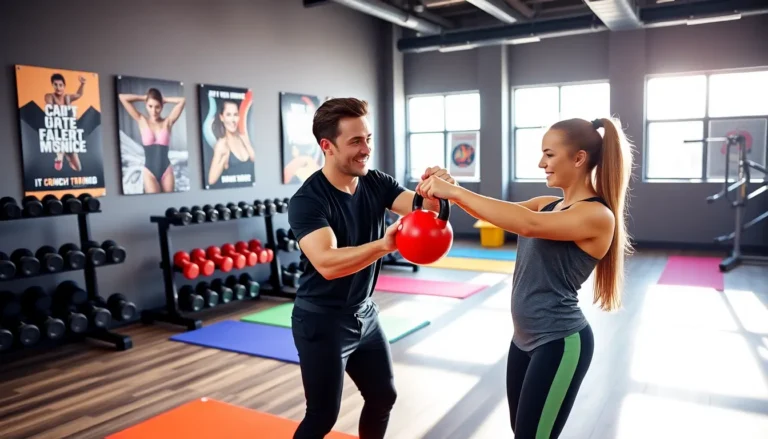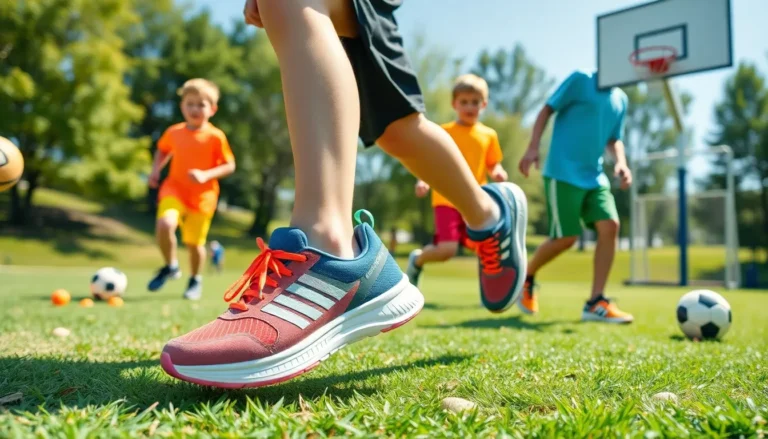In a world where everyday tasks can feel like Olympic events, it’s time to level up with a functional fitness training program. Forget about lifting weights just for the sake of it; this approach prepares the body for real-life challenges. Whether it’s hoisting groceries or chasing after a runaway toddler, functional fitness equips individuals with the strength and agility to tackle life’s surprises head-on.
Table of Contents
ToggleOverview of Functional Fitness Training Program
Functional fitness training focuses on exercises that replicate everyday activities. This type of training enhances strength, balance, and coordination, improving overall physical function. Exercises commonly include movements like squats, lunges, and push-ups, which engage multiple muscle groups simultaneously.
Participants often benefit from increased flexibility and core stability. Enhanced core strength plays a crucial role in supporting the spine and preventing injuries. Training programs typically integrate resistance training along with aerobic activities to maximize effectiveness.
A well-rounded functional fitness training program consists of various components, such as agility drills, strength exercises, and cardiovascular workouts. Including these elements provides a comprehensive approach to overall fitness. Structured routines promote both skill development and physical conditioning, vital for performing daily tasks.
Programs can be tailored to suit different fitness levels, making them accessible to a wide audience. Modifications allow beginners or those recovering from injuries to participate without strain. Alternatively, advanced participants can increase intensity to meet their fitness goals.
Outdoor environments or gym settings often host functional fitness classes, allowing for community engagement and support. Group classes foster motivation and camaraderie, enhancing the overall experience. Furthermore, many programs integrate purpose-driven challenges, which encourage personal achievements and progress tracking.
Task-specific training, such as lifting, reaching, or balancing, helps prepare the body for real-world situations. Techniques used in most programs emphasize safe and functional movement patterns. This ensures participants build the necessary skills for everyday life activities, promoting long-term health and fitness.
Benefits of Functional Fitness Training
Functional fitness training offers numerous advantages that significantly impact everyday life. This training enhances physical abilities through exercises that mimic daily tasks.
Improved Daily Functionality
Improved daily functionality represents a key benefit of functional fitness training. Participants notice an enhancement in their ability to perform routine activities, such as climbing stairs, lifting objects, and bending down. Increased strength and coordination translate directly into a more active lifestyle. Additionally, engaging in functional exercises helps individuals tackle unexpected challenges, like carrying groceries or playing with children. Improved balance and agility contribute to better overall stability. These benefits not only elevate daily performance but also foster independence as people age.
Enhanced Strength and Flexibility
Enhanced strength and flexibility are fundamental advantages of functional fitness training. Participants experience increased muscle strength through exercises like squats and lunges, which target multiple muscle groups simultaneously. Improved flexibility occurs as movements prioritize stretching and joint mobility, reducing injury risk. Enhanced core stability from functional fitness supports the spine, promoting better posture. When combined, these improvements lead to greater physical performance in various activities, from sports to recreational pursuits. Stronger and more flexible individuals enjoy higher energy levels, contributing to overall wellness.
Key Components of a Functional Fitness Training Program
A functional fitness training program includes several critical components that enhance overall physical capabilities. These elements allow individuals to perform daily activities with greater ease and effectiveness.
Strength Training
Strength training forms the backbone of functional fitness. Exercises such as squats, deadlifts, and push-ups engage multiple muscle groups, promoting overall muscle development. This type of training increases functional strength, which translates directly to everyday tasks. Additionally, participants can modify exercises based on their fitness levels, ensuring safety and effectiveness for everyone. Progressing in weights or resistance boosts both muscle mass and metabolic health, ultimately supporting long-term wellness.
Balance and Stability Exercises
Balance and stability exercises are essential for maintaining a strong foundation. Activities like single-leg stands or stability ball exercises enhance core strength and coordination. Improved balance reduces the risk of falls and injuries, especially in older adults. Participants can experience greater control in their movements, enabling them to navigate everyday challenges with confidence. Integrating these exercises into a training program enhances overall body awareness, which is crucial for functional movements.
Cardiovascular Conditioning
Cardiovascular conditioning also plays a vital role in functional fitness. Engaging in high-intensity interval training (HIIT) or circuit training elevates heart rates while building endurance. Increased aerobic capacity enhances overall stamina for physical tasks, making daily activities feel less taxing. Additionally, participants gain significant health benefits, such as improved circulation and enhanced lung capacity. Incorporating various cardio exercises keeps workouts fresh and enjoyable, promoting long-term adherence to a functional fitness program.
Designing a Functional Fitness Training Program
Creating a functional fitness training program involves a careful understanding of individual capabilities and goals. Each program should cater to unique needs, promoting maximum effectiveness and engagement.
Assessment of Individual Needs
Assessing individual needs forms the foundation for any effective training program. Trainers evaluate current fitness levels, identifying strengths and weaknesses. Specific goals, such as improving endurance or enhancing mobility, guide the design process. Combining assessments with personal preferences boosts motivation, keeping participants engaged. Comprehensive evaluations often include flexibility tests, strength assessments, and movement screenings to address any mobility restrictions. Proper assessments aid in tailoring exercises that suit various fitness levels, from beginners to advanced athletes.
Structuring a Balanced Routine
Structuring a balanced routine ensures comprehensive fitness development. Incorporating strength training, balance exercises, and cardiovascular conditioning promotes overall well-being. Strength training focuses on major muscle groups, utilizing compound movements like squats and lunges, which mimic daily activities. Balance exercises enhance coordination, reducing fall risk, particularly for older adults. Cardiovascular conditioning integrates high-intensity interval training or steady-state cardio to build endurance and stamina. Rotating through these components keeps workouts fresh and engaging, while also preventing overuse injuries. Adapting routines to progress over time ensures continuous improvement, fostering long-term dedication and results.
Embracing a functional fitness training program can transform how individuals approach their daily activities. By focusing on movements that mimic real-life tasks, participants not only build strength and agility but also enhance their overall quality of life.
Tailoring these programs to meet individual needs ensures that everyone can benefit regardless of their fitness level. With the right balance of strength, balance, and cardiovascular training, functional fitness empowers individuals to move with confidence and ease.
Ultimately, this approach fosters a sense of community and motivation, making fitness an enjoyable and rewarding journey. As individuals notice improvements in their daily routines, they’ll find that functional fitness is not just about working out; it’s about living life to the fullest.





